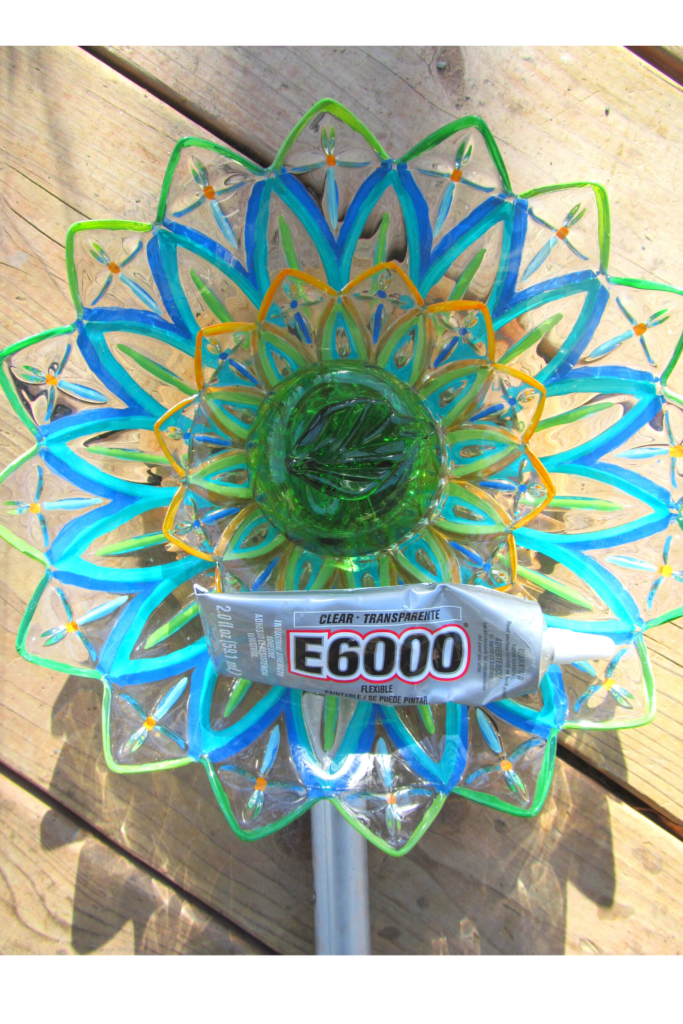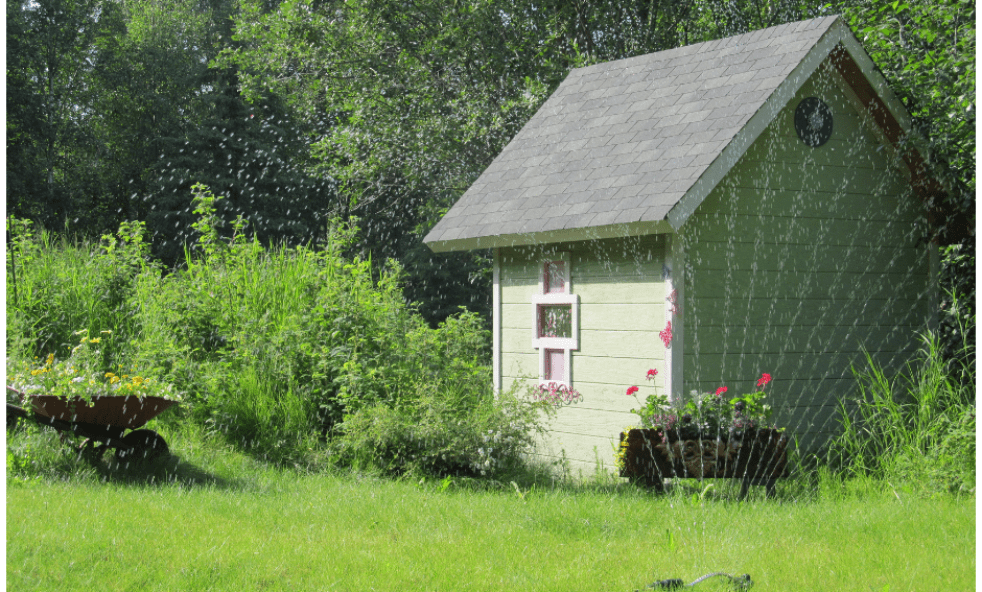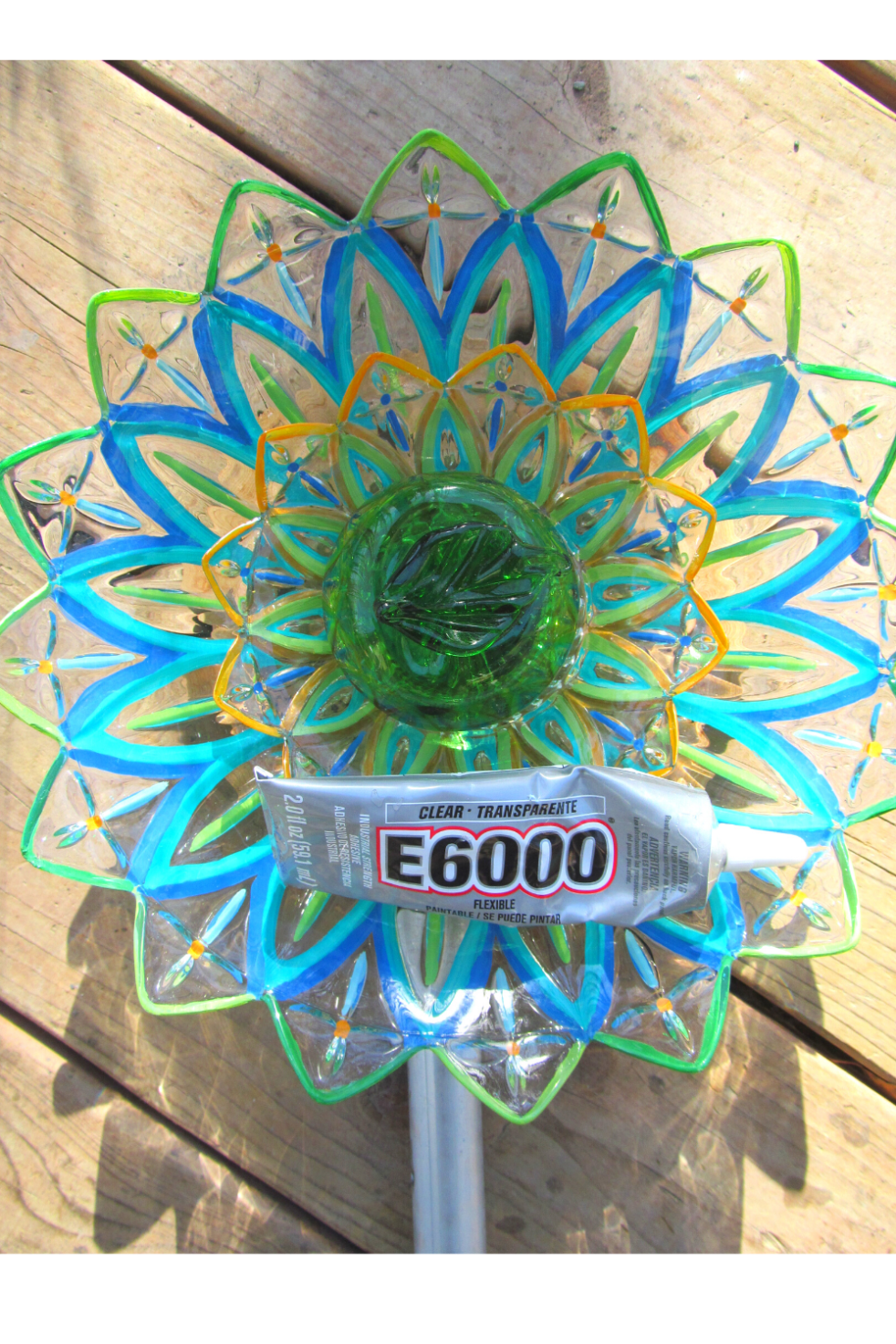
As an artist who makes and sells my own garden art…well…let’s just say you learn the ins and outs of various glues. Let me start by saying, that I use E-6000. It’s a good industrial glue and particularly good for glass art or repairing a broken tea cup. But there are some unique circumstances when E-6000 is not the glue to use. This short article addresses this problem.
This should not be perceived as a criticism about E-6000. It’s not. Rather, what I wish to do, is to point out the limitations of E-6000 when it comes to making dish flowers and other garden art that—in “some” situations–may exceed the limitations of what the glue was intended for.
E-6000 special considerations
One of my readers, Cynthia writes: “What kind of glue do you use? I’ve tried E-6000 and things fall off frequently. I do live in a very hot Western, CA.”
If you love making re-purposed garden art such as “dish flowers” you have probably encountered the same problem Cynthia did. You spent hours at the thrift store or garage sale-ing scrounging up pretty dishes. After completing your artwork, you proudly set it out in the garden for all to admire.
But at some point, it fell apart. And that’s frustrating. You may have heard through Pinterest or a You Tube video that E-6000 is the glue everyone recommends for glass garden art. No one is wrong to say this!
However, if you live in a hot climate where your dish flower is exposed to long hours of sun, E-6000 will likely fail. It’s NOT the fault of the glue, but rather that E-6000 is not intended for this kind of application.
It’s because of this that there is so much seeming “irregularity” among a crafter’s experience with the product.
E-6000 and heat
E-6000 is a strong bonding glue, but weight is an equally important factor. And let’s face it: dish flowers are kind of a special form of art. Glass and ceramic dishes are heavy. Outside in the garden, they are displayed vertically. How well the glue performs under extreme conditions may vary a lot based on the method of construction. This is why I use and encourage the drill method for making dish flowers.
According to the manufacturer, E-6000 is good for temperatures of 180. It doesn’t get that hot on planet earth, so it’s natural to think you’re good to go. But in reality, 180 is not that hot. Think in terms of baking a cake in your oven. 325 degrees is considered a medium heat, while pizza is baked at 405-420 degrees.
On the subject of baking, there are different temperature settings or bake times for metal or aluminum pans verses glass ones. Why? Because glass absorbs heat.
Likewise with dish flowers, those glass and ceramic plates not only absorb heat, but retain heat. When the glue begins to soften mean Mr. Gravity sends plates shattering to the ground. With day after day in direct sunlight, you can see how that glue might be put to the test, especially in one of those notorious California heat waves. And other locations, too, of course. But not ALL locations. In my state, we don’t have any issues at all with E-6000!
Other things that cause glue to fail
Besides heat, there are other factors at play, too, that might contribute to glue failure.
- Not allowing enough time for the glue to fully cure
- Not using enough glue or not applying it correctly
- Less than optimum surface to surface contact
- A glue’s chemical reaction to certain metals (zinc, copper, nickel, aluminum)
Again, E-6000 is a fine product! However, it might not be the right glue for certain types of outdoor artwork in certain climates that stretch its capabilities.
E-6000 is commonly found at craft stores like Michaels and hardware stores like Lowes in the paint department.
Encouragements
First off, I want to encourage you. If you’ve tried to make dish flowers before and it hasn’t worked out, please try again. You may wish to experiment with a different adhesive such as 100% silicone, or a different construction method.
Was this article helpful? Please leave a comment below. I’m always available to answer questions, too. Just click “Get in Touch” which you’ll find at top on your sidebar or at the bottom of the post on a mobile device.
about the author

Kristen loves anything that makes a garden a more inviting and inspiring place to spend time. She is known for her whimsical dish flowers, totems and other artworks made from repurposed materials. If ya have a moment, drop by my studio and say hello!
Garden Art Tutorials
Comprehensive Dish Flower Tutorial
Painting on Clear Glass Dishes
Cheerful & Easy Plastic Dish Flowers
The form you have selected does not exist.


Thank you for taking the time to clarify this concept. While I have not YET made any of these dish flowers, it is helpful to understand the different mechanics of construction, as well as, the reasons a particular product may not work as well.
Yes, that is precisely why I wrote it. I live in a state where summers do not get that hot…even in full sun. Usually. Lots of crafters use E-6000. But I quickly learned that people in other parts of the U.S and even parts of England and Australia can’t use it. If the craft is for indoors, then, not a problem. I always try to make the effort to be helpful so someone can better enjoy making their garden art.
I called the manufacturer about the glue. Was told shelf life after opening was limited to 6 months. And to always check the date before buying as there is also a limited time to be purchased for use with glass art. Hope this helps.
Good tip!
I really like the GE silicone. I worked with that silicone when I lived in Southwest Colorado to make hardscape art and it worked excellent!! Summer temps would get up to 100 degrees at times.
Yup! The manufacturer gives silicone a heat rating of 400 degrees. A lot of modern baking pans, pot holders etc. are made from silicone. I like that it is thick, and low odor.
I also use the GE silicone glue. I use GE silicone 7X I live in New England and I have kept my garden flowers out accidentally all year and they have with stood both the cold of the winter and the heat of the summer. Best product on the market. I use E 6000 on glass that I want to dry clear GE silicone glue yellows overtime it’s it’s only downfall.
Thank you for all the information I will try the silicone on my next art work thank you.
You’re welcome. Let me know if you have further questions.
Thank you for the clarification. This was helpful!
You’re welcome!
Hi Kristen, I made about10 glass flowers this year for the first time. My son and I tried drilling holes for mounting but broke 2 plates right away, so I tried the glue method with E6000. At first everything went fine, but now I’m finding a lot of my plates have cracks! The glue held fine, but the glass is breaking. I put them together in a normal 70 degree room and they havnt been exposed to extreme temperatures. Any ideas on what’s causing this?
Some plates are not drillable…usually if they are too thin (I’ve broken a few myself). Corelle brand is also not drillable. The cracks may be from the E-6000. Glue shrinks as it cures and on thinner glass- particularly if you used a lot of glue- it could crack the glass. I’ve had this happen before with E-6000, so lesson learned. E-6000 is NOT like Elmers; you don’t have to use a lot of it. That’s a lot of torque/pressure on the glass. I would try using thicker glass or using less glue. You might also try silicone (clear) that comes in the squeeze tube. It doesn’t shrink because it’s a caulk and not a true “glue”. Let me know how it goes!
This was a very helpful insightful article
Thank You
Can you please share any helpful drilling tips about drilling glass?
Here’s a link to my post about how to drill a plate. It’s very detailed and also contains a video demonstration of how to do it! https://makeitagarden.com/how-to-drill-a-plate-for-garden-art/
I made a glass flower using a marine adhesive. It has been outside 24/7 for about 5 years. I live in Ohio. The adhesive is a little expensive. But if you don’t want to drill Glass, this is the way to go.
Thanks for the suggestion. It may be something another reader may want to try.
Silicone did not work for me, even after letting it cure for over a week. The epoxy, however, did. I’m going to try the marine glue next 🙄
I have always said ‘use what works best for you’. I’m curious though why the silicone didn’t work? But if you have success with epoxy, by all means, stick with that. The most important factor is for the adhesive to hold up in high temperatures if you live in that type of climate. Most of all, I’m glad to see you trying different glues and being determined! That’s the spirit!
The drilling method is best but timely and patient’s is needed to prevent cracking of plates Al’s carefully not to over tighten nuts. I met a woman at a boutique three yrs ago whom was selling the plate flowers and she swore by e6000. I thought I’d purchase one of hers to see if it did hold up as she stated. The plate consisted of 6 thick plates. I placed it in my planter where it’s been exposed to all california temperatures and inviroments so far its still intact. I have collected a Hugh box of plates with good intentions but not done any yet. Going to gamble and try e6000 industrial.
Drilling plates is my recommendation (it’s how I make my flowers) and I have a tutorial on it. As mentioned in the article…with ANY glue or adhesive… the important factor is the heat rating. E-6000 ‘Industrial’, doesn’t have a high heat rating (if I recall). Glueing is way easier and I can see why it might be preferred. There may be some areas or conditions in which E-6000 can work. (Keeping your dish flowers in a shaded location, for example); or an area that doesn’t have long, super-hot months. But I’ve always said, go with whatever works for you.
I am making a birdbath by attaching a terracotta tray to a grapevine wreath, I am also attaching ceramic birds one wreath. I live in Atlanta and it gets in the nineties pretty regular during the summer. What’s the best glue to use? I was planning on E6000 but now I question it.
Definitely DO NOT use E-6000. I’m trying to envision your project. How are you attaching the tray? Will it sit in the center of the wreath so you can hang the wreath? Does the wreath go all the way around…a full circle, or does the tray sit at the bottom and the wreath arcs from the sides overhead, like 1/2 circle? Are you trying to glue the wreath to the tray? Without details, I’m not certain how to advise. If you’re going to try to glue, I’d use 100% silicone for exterior. It’s thick and stays put. Strong, Water-proof and sun-proof, adheres well to ceramic surfaces. The other recommendation would be to drill two small holes on either side of the terracotta tray and use a heavier gauge wire to connect the tray to the wreath. Hope this is helpful!